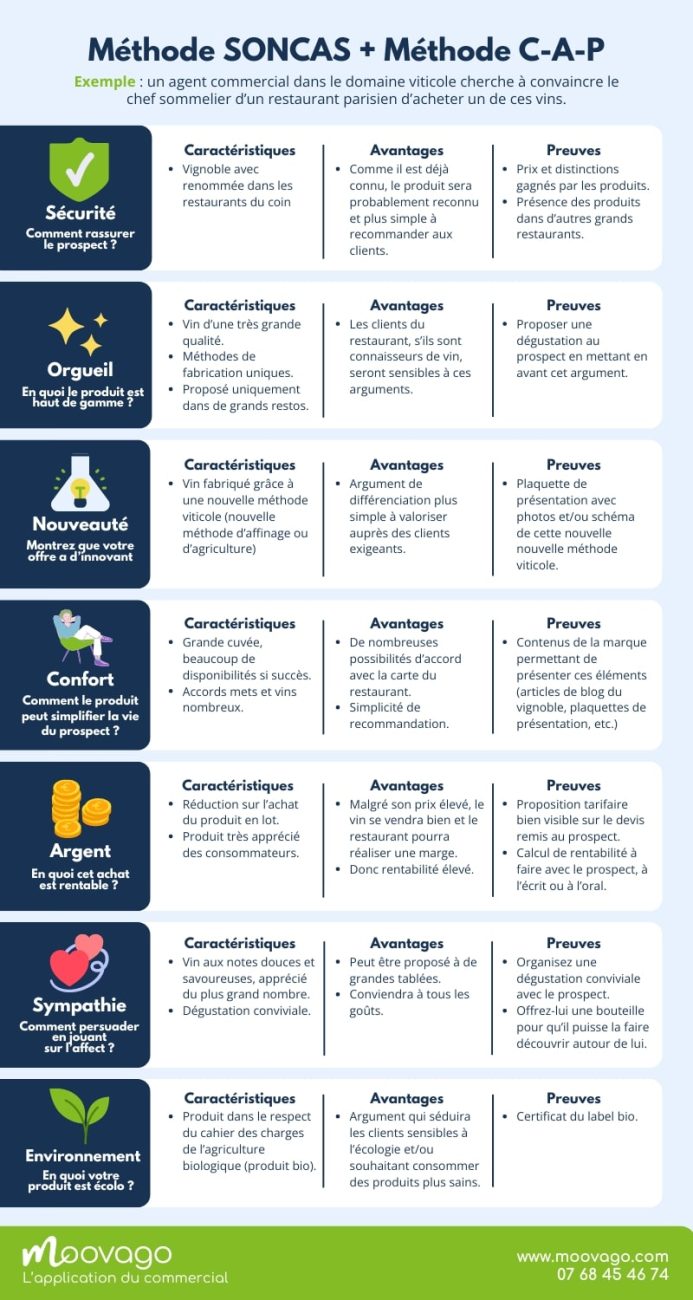The SONCAS method definition
Created in 1993 by Jean-Denis Larradet, the SONCAS method is a sales technique designed to understand prospects’ buying motivations based on 6 levers. These motivations are easy to remember, as SONCAS is in fact an acronym made up of these 6 dimensions:
- Safety,
- Pride,
- Novelty,
- Comfort,
- Silver
- Sympathy.
In recent years, SONCAS has evolved into SONCASE to include a 7th buying motive, known as Environment or Ecology. This is known as the SONCAS method.E (Security, Pride, Novelty, Comfort, Money, Sympathy, Environment).
This sales analysis technique is based on an understanding of basic human needs, as it is inspired by Maslow’s pyramid of needs.nspired by Maslow’s pyramid of needs. Understanding and applying the SONCAS method is essential for sales professionals keen to adapt to their customers’ needs.
The advantage of the SONCAS method? It’s relevant to all salespeople and all sectors. It can be used with potential B2B and B2C customers to identify the psychological profiles of prospects and customers.

Apply the CAP SONCAS method to your next appointments
Would you like to apply the CAP SONCAS method to your next sales meeting? Download our free CAP SONCAS model chart and the method’s summary sheets.
We’ll explain how to fill in this table in the rest of this article.
The 6 levers of the SONCAS method
The SONCAS method is based on the analysis of the deep motivations of prospects or customers, divided into 6 psychological levers (or 7, if we talk about SONCASE). Before we look at how to use SONCAS for sales, let’s see what each of these dimensions corresponds to.
SONCAS: S for safety
The first dimension of the SONCAS method is Security. It’sone of the most important buying motives in the sales process.
It’s not for nothing that the need for security is one ofthe most fundamental needs according to Maslow’s pyramid!
This is one of the needs that consumers will seek to satisfy first, before considering other purchasing factors. For example, if a consumer doesn’t feel safe at home, he or she will probably want to buy a video surveillance or alarm system first, before thinking about beautifying the home.
More generally, customers seek to minimize risk when making purchasing decisions. If a customer has the slightest doubt, it can jeopardize the whole sale… And for some customers, this feeling is greatly exacerbated!
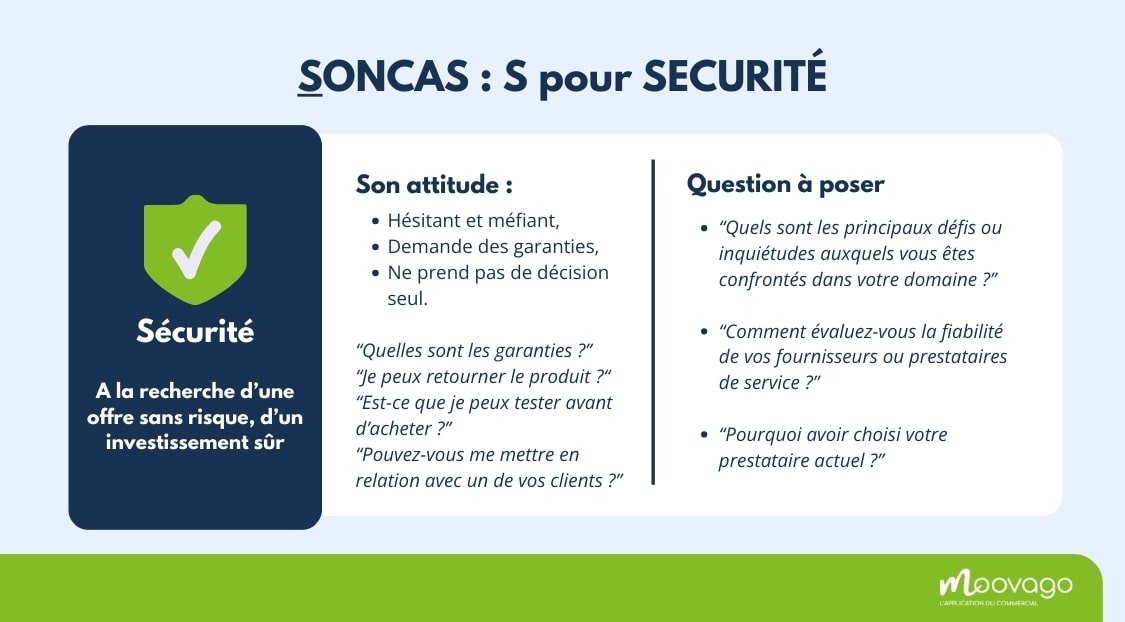
SONCAS: O for Pride
The pride lever is powerful in sales, because it affects the customer’s self-perception. Customers are often attracted by products or offers that flatter their ego. There is a whole range of products which, apart from their function, have a real social impact and flatter this dimension (cars, watches, fashion or luxury watches…).
However, even for more “common” products, salespeople can exploit this leverage by highlighting elements that emphasize the product’s status, prestige or uniqueness.
Customers motivated by pride may be sensitive:
- To quality,
- Limited editions,
- The reputation and image of the brand offering the product or service,
- Customization elements.
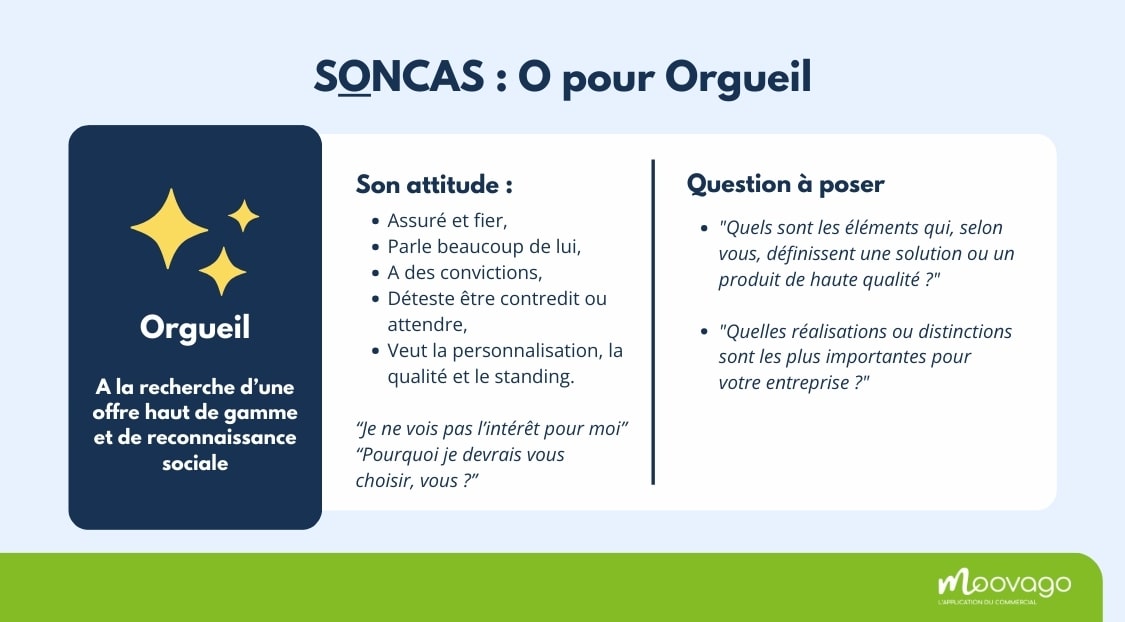
SONCAS: N for New
Novelty is a powerful lever for many customers. Human beings have a natural fascination for what is new and innovative. To leverage this, salespeople need to present their product or service as innovative.
Our advice? Emphasize how your product is innovative, based on your sales pitch and the features of your product. Of course, consumers will expect more from a hybrid vehicle than from a sponge in terms of innovation. However, all products and services can be innovative in their own way.
So how do you find out how your product or service fulfils this “Novelty” dimension? Here are a few ideas to get you started:
- An innovative feature of your product or service (manufacturing, design approach, etc.),
- Your company’s CSR approach,
- Integrating trendy elements such asartificial intelligence into your product/service,
- A new collection,
- A new product,
- Etc.
Here are a few questions to help you understand whether your customer is sensitive to the novelty dimension:
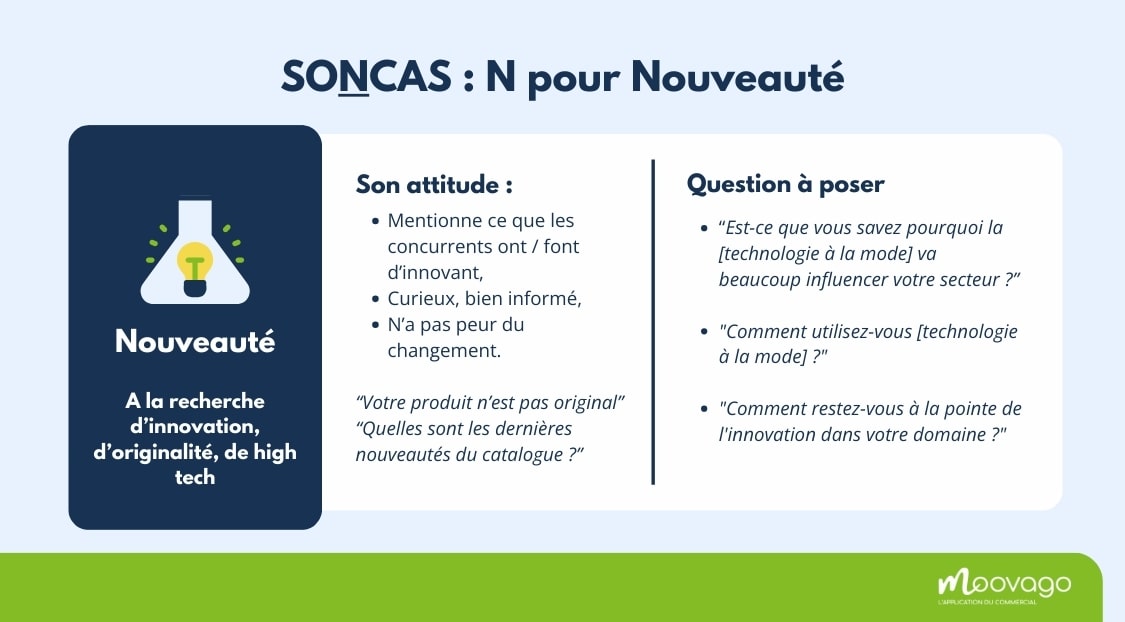
SONCAS: C for comfort
- The product’s ease of use,
- How does it make everyday life easier?
- All the information they need to help them make decisions, get to grips with the product, and so on.
- Product or service benefits that reduce the effort required to achieve a positive result.
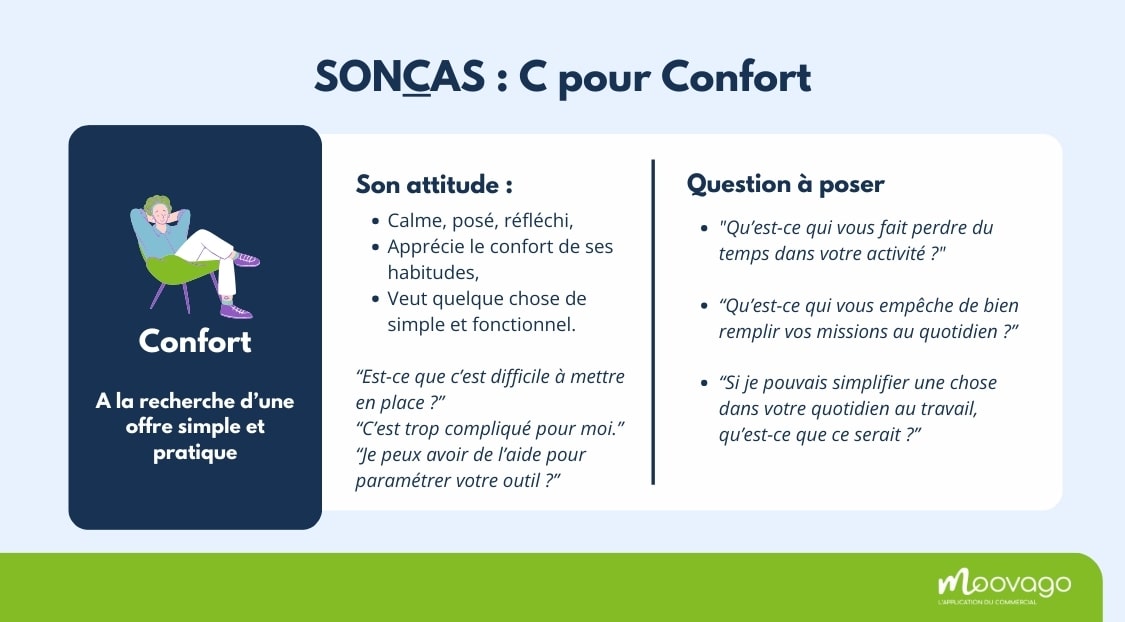
SONCAS: A for Silver
Dear salespeople, we’re not trying to teach you anything by pointing out thatmoney is a key lever in sales. Most customers want to be sure that their money is well invested… And rightly so! Salespeople must therefore demonstrate the profitability and value of their product or service.
The greater the cost of the product or service, the more the question of money is likely to become an issue. To make a purchase, your prospect needs to be convinced that he’s making a medium- to long-term investment.
When faced with a prospect motivated by money, here are a few points to consider:
- Highlight the value for money of your solution (this applies whether the product is cheap or not),
- Emphasize the immediate or long-term financial benefits (future savings? good return on investment? exceptional product lifespan?),
- Make promotional offers available (even if it means a token discount),
- Compare your solution to other, less advantageous ones, to support your point.
Here is a small summary sheet for this lever:
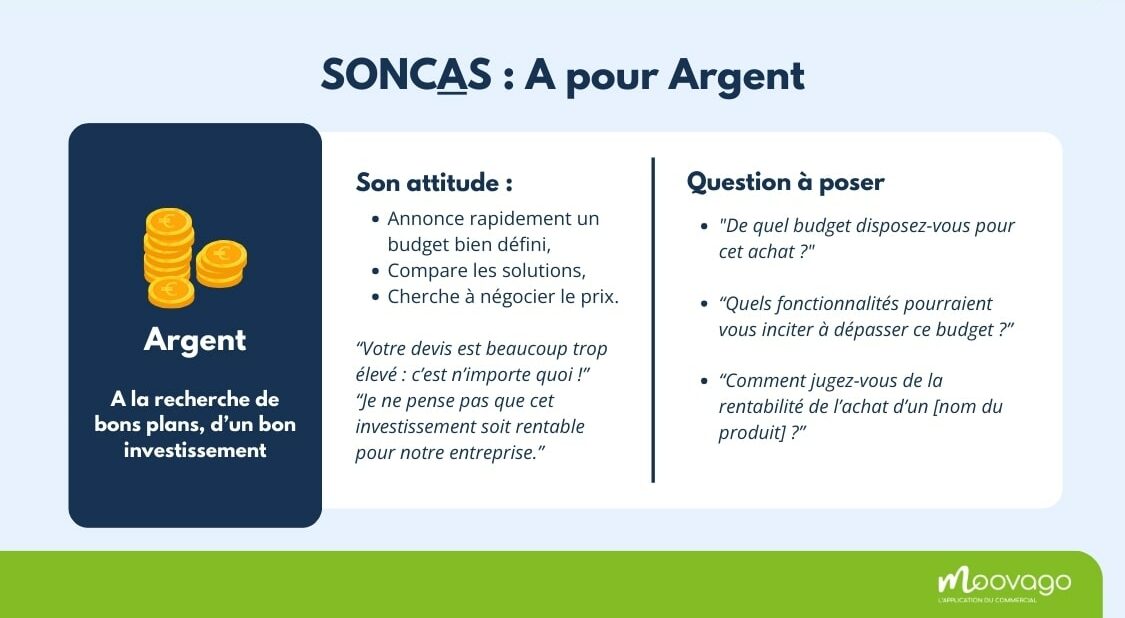
SONCAS: S for Sympathy
The Sympathy component of SONCAS takes into account two elements that must be clearly distinguished.
On the one hand, your prospect’s Sympathy towards you, which can motivate their purchase: vur potential customers will be more inclined to buy from you, if you’ve established a genuine connection with them beforehand.
Here are some tips on how to put this into action:
- Be a good listener.
- Empathize: put yourself in your prospect’s shoes.
- Build trust by showing that you’re there to help, not just sell.
- Be honest, transparent and propose solutions that really meet your customers’ needs.
- Seek to strengthen your connection with your prospect.
On the other hand, Sympathy can correspond to the desire to have a beautiful, pleasant, friendly or convivial product.
For the “Sympathy” SONCAS lever, the SONCAS questions would be, for example:
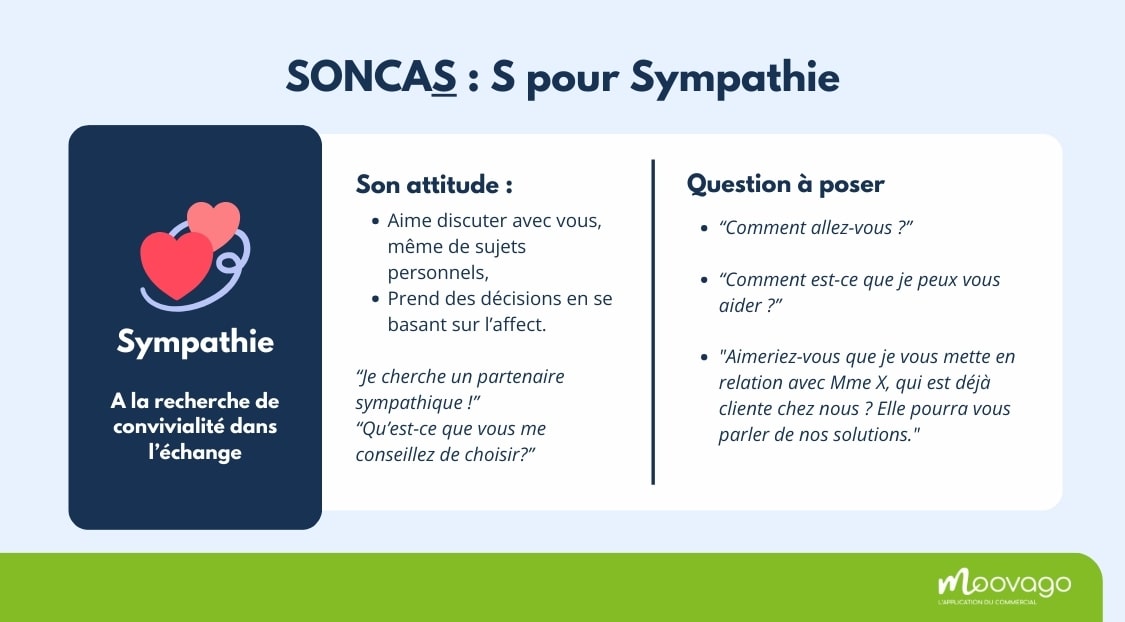
SONCAS(E): The E for Environment
The E, from the SONCASE method, refers to a 7th dimension, “Environment”.
This is sometimes debated, considering that the Environment is a novelty, a trend, and can also be associated with “Novelty”.
So how do you make the most of it?
- Show that your company is eco-responsible. Think about manufacturing methods, products used, etc.
- Emphasize the local aspect if possible: for example, if your products are made in France, say so.
- Show that you’re reducing waste and your carbon footprint over time. It’s also possible to demonstrate that you take care to ensure the healthy composition of your products.
- Check whether your company complies with environmental standards such as ISO. If so, don’t be shy – show it! This will boost your customers’ confidence.
For the “Environment” lever, here is an example of a SONCAS table:
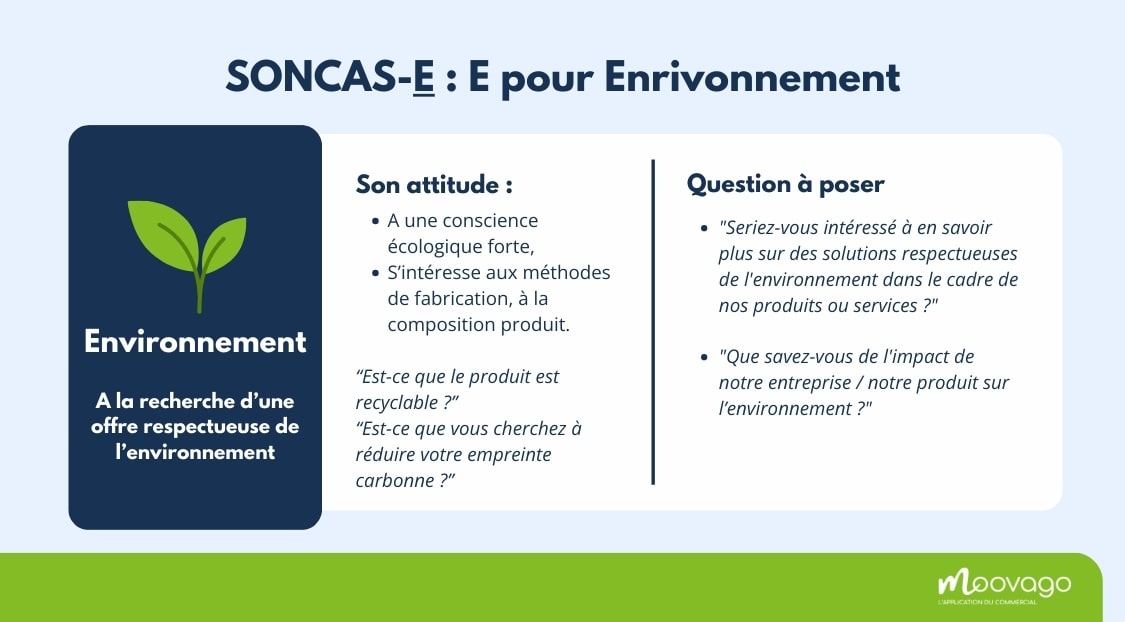
Link need and solution with the CAP SONCAS method
Definition of the CAP SONCAS method: what is the CAP SONCAS method?
The CAP SONCAS method is a blend of SONCAS and another sales technique, CAP: Characteristics-Advantages-Proofs.
To use the CAP method, salespeople must follow a 3-step process:
- Identify features: Start by presenting the distinctive features of your product or service. These may include a more or less detailed presentation, depending on the prospect: technical specifications, features, important aspects.
- Highlight the benefits: For each feature, identify the advantages it offers the customer. How does it solve a problem or meet a specific customer need?
- Provide proof: Provide tangible evidence of the quality and value of your product or service. This can include customer testimonials, case studies, performance data, or certifications.
SONCAS table: an example of the CAP SONCAS method
You’re probably wondering how to use the CAP SONCASE sales analysis grid with a concrete example?
Let’s see how these two methods can be linked, with an example. Let’s imagine a sales agent for a vineyard, visiting a prospect, who would be a sommelier in a top Parisian restaurant:
Click to download the table template below (+ all SONCAS method summary sheets). 👇
When should the SONCAS method be applied?
Now that we’ve seen what the SONCAS method is and how to combine it with the CAP method, it’s time to get down to the nitty-gritty: when does it come into play in your commercial sales?
Quite often, you’ll have towait for a sales meeting with your customer to have the time you need to ask your customer/prospect for the information you need to carry out this analysis, especially during the discovery phase. Once this analysis and preparation phase has been completed, the CASE SONCAS method will be of great help in the subsequent stages (value proposition, negotiation and closing).
Let’s take a look.👇
How to use the SONCAS method during the discovery phase?
During the discovery phase, it’s essential to understand the prospect’s needs and motivations.
During a sales meeting or exchange, the best tactic is :
- Ask questions, giving preference to open-ended ones.
- Adopt an active listening attitude to get the prospect talking as much as possible.
- Take notes, listen to what he tells you, and follow up with increasingly precise open-ended questions to probe each point further.
Make sure you ask the right questions! For example, when you think you’ve understood what motivates your prospect, try to confirm your hypothesis. To do this, don’t hesitate to use the questions mentioned earlier in this article, and rephrase to ask for confirmation.
Ultimately, your prospect will be able to express his or her buying motivations.
How can SONCAS be used in the value proposition phase?
Once you’ve identified what might motivate or slow down your prospect’s decision to buy, it’s time to deploy the power of the SONCAS method in the value proposition phase.
You have all the cards in hand to present your potential customer with the aspects of your product or service that will make the most sense to them.
👉 Personalize the sales pitch you know so well, and select only those arguments that will have the greatest impact.
So it’s highly likely that you won’t list all the product’s features or all the points in your sales pitch. The idea is to select only what will convince the person in front of you.
How to use the SONCAS method during the negotiation and closing phase?
Prospects will often interrupt the salesperson’s presentation on a specific point to make their point. This can happen during the presentation (presentation phase / value proposition) or during the negotiation phase, more towards the end of the exchange.
But don’t panic: the SONCASE method already provides you with the keys to resolving this negotiation and argumentation phase. It’s highly likely that your prospect will emphasize elements linked to his buying motivations, as identified with the SONCAS analysis grid.
Unsurprisingly, a huge proportion of the objections salespeople have to deal with are money-related. However, your prospect may focus on another aspect of your solution, if his or her main concern isn’t money.
Once again, it’s up to the salesperson to use his or her talents to re-link the Features, Benefits and Proofs that will dismantle these objections.
How to use the SONCAS method in writing?
Since your exchanges with prospects and customers are not limited to your appointments, it’s obvious that the SONCAS or even CAP SONCAS method can be applied to many other situations.
In writing, for example, when exchanging e-mails or messages, you can apply the various points discussed in this article.
Even if the written word may seem less natural for this exercise, you’ll have more time to prepare your answers and be convincing! What’s more, after your meetings, don’t hesitate to email your prospects to remind them of the key points in your presentation, or to add to your sales pitch with a few points you may have missed.
Maximizing sales force efficiency
To make the most of the SONCAS method, it’s essential to train your sales force in this exercise.
Not only do you need to know your sales pitch inside out, but you also need to master active listening: in other words, you need to listen while analyzing the buying motive of the person in front of you, and at the same time think about the most relevant characteristics, advantages and proof (CAP) to use this SONCAS lever! In short, it’s all about gymnastics, which you need to take the time to prepare if you want it to be effective!
To ensure that your sales force is ready to use the CAP SONCAS method, make sure that every :
- Understand the different psychological levers and know how to identify them in a discussion,
- Have a CAP SONCAS sheet filled in according to the product/service marketed (and that he/she knows it well 😉 ), which will greatly ease his/her analysis work during appointments,
- That they are comfortable enough with their sales pitch to personalize it according to the SONCAS levers identified.
Go further: Find out how to set up a training program for your sales force.
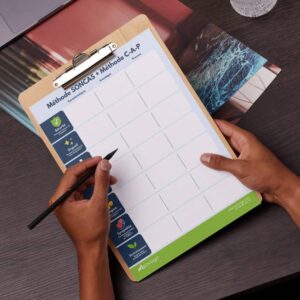
Apply the CAP SONCAS method to your next sales meeting
Would you like to apply the CAP SONCAS method to your next sales meeting? Download our free CAP SONCAS model chart and the method’s summary sheets.
We’ll explain how to fill in this table in the rest of this article.

